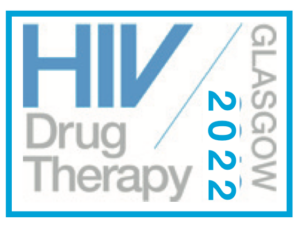Glasgow 2022: Islatravir studies to use 0.25 mg daily dose to overcome risk of reducing CD4 and total lymphocytes
1 December 2022. Related: Conference reports, Antiretrovirals.
Kirk Taylor, HIV i-Base
 HIV Glasgow included a late-breaking presentation of a model to explain the unexpected drop in CD4 cells and total lymphocytes that led to most clinical studies of islatravir (ISL) being stopped in December 2021. [1, 2]
HIV Glasgow included a late-breaking presentation of a model to explain the unexpected drop in CD4 cells and total lymphocytes that led to most clinical studies of islatravir (ISL) being stopped in December 2021. [1, 2]
ISL is a highly potent NRTTI under development for HIV treatment and prevention. After dosing, it is phosphorylated to ISL-TP in lymphocytes. However, the extremely long half-life of ISL led to accumulation of high levels of ISL-TP that were cytotoxic to CD4 and total lymphocytes.
Total lymphocyte and CD4 counts were modelled using data from four clinical studies of ISL that used QD (0.25 to 2.25 mg) or QM (60 to 120 mg) regimens. The greatest drops in lymphocyte and CD4 counts were associated with the 0.75 mg dose. Using 0.25 mg gave comparable lymphocyte counts to other ART regimens.
The present study aimed to establish an optimal dose that does not impact lymphocyte counts, whilst maintaining efficacy against HIV. Data were collected from trials with HIV negative (protocol P016; 60 mg and 120 mg QM), treatment naïve (P011; 0.25, 0.75 and 2.25 mg QD) and virologically suppressed (P017 and P018; 0.75 mg QD) participants. There was a minimum of 36 weeks of data for each trial and participant numbers ranged from 30 to 330 per arm.
Two models were built to assess ISL-related changes in total lymphocyte and CD4 counts. Efficacy was evaluated for wild-type (WT) and M184I/V HIV-1 strains. ISL (0.25 mg QD) achieved efficacy against both strains with 4 days of initiation.
Changes in CD4 counts were benchmarked against 50 published ART switch studies that included >19,000 participants. Change in CD4 counts fell mostly within the range -5% to +10% and this was used for ISL studies.
Modelling predicted a dose-dependent decrease of total lymphocyte and CD4 counts with the greatest reduction seen with 2.25 mg ISL. For 0.25 mg QD ISL, total lymphocyte and CD4 counts at week 48 were 97.5% (95% PI: 92.7% to 103%) and 98.4% (95% CI: 91.4% to 105.0%) of control, respectively. Predicted total CD4 counts were 700 cells/mm3 (95% PI: 649 to 753) for 0.25mg ISL and 719 cells/mm3 (95% PI: 664 to 766) for comparator ART.
A phase 3 study is underway to evaluate efficacy of DOR/ISL (100/0.25mg) for people living with HIV who are virologically suppressed or treatment naïve. Safety monitoring will include quarterly CD4 counts.
References
- Vargo R et al. Modelling and simulation to optimize islatravir doses in HIV treatment naïve and virologically suppressed populations. Oral 45. HIV Glasgow, 23 to 26 October 2022.
https://onlinelibrary.wiley.com/doi/10.1002/jia2.26009 (abstract)
https://virtual.hivglasgow.org/programme/late-breakers-hot-topics (webcast)

